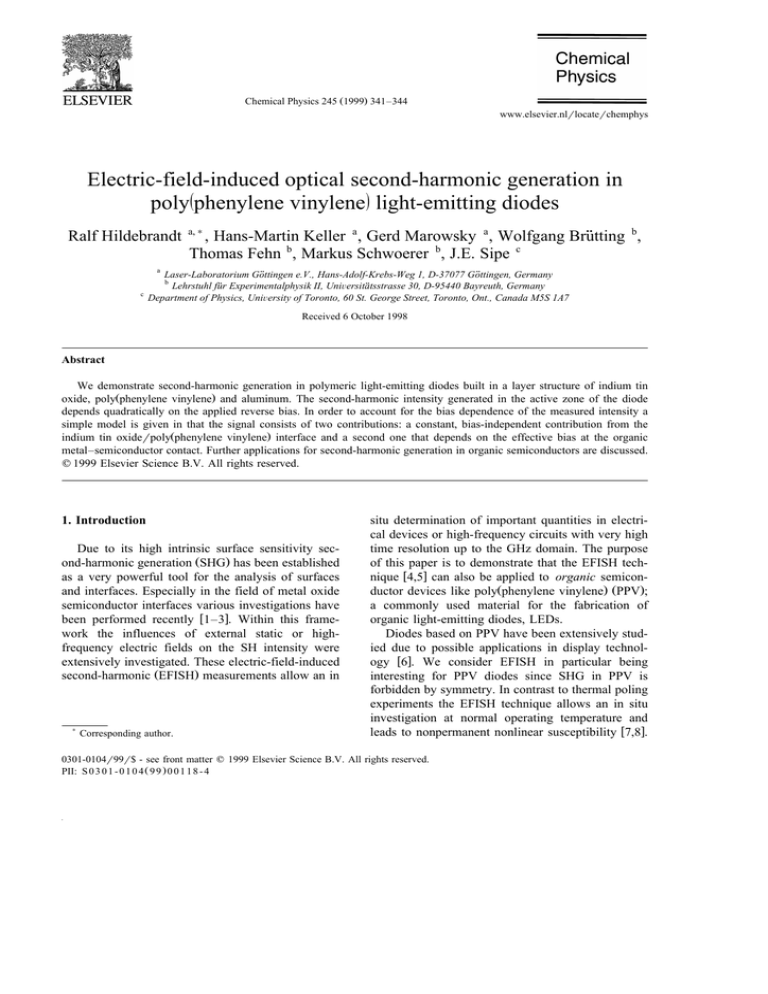
Chemical Physics 245 Ž1999. 341–344
www.elsevier.nlrlocaterchemphys
Electric-field-induced optical second-harmonic generation in
poly žphenylene vinylene / light-emitting diodes
Ralf Hildebrandt
a,)
b
, Hans-Martin Keller a , Gerd Marowsky a , Wolfgang Brutting
,
¨
Thomas Fehn b, Markus Schwoerer b, J.E. Sipe c
a
c
Laser-Laboratorium Gottingen
e.V., Hans-Adolf-Krebs-Weg 1, D-37077 Gottingen,
Germany
¨
¨
b
Lehrstuhl fur
30, D-95440 Bayreuth, Germany
¨ Experimentalphysik II, UniÕersitatsstrasse
¨
Department of Physics, UniÕersity of Toronto, 60 St. George Street, Toronto, Ont., Canada M5S 1A7
Received 6 October 1998
Abstract
We demonstrate second-harmonic generation in polymeric light-emitting diodes built in a layer structure of indium tin
oxide, polyŽphenylene vinylene. and aluminum. The second-harmonic intensity generated in the active zone of the diode
depends quadratically on the applied reverse bias. In order to account for the bias dependence of the measured intensity a
simple model is given in that the signal consists of two contributions: a constant, bias-independent contribution from the
indium tin oxiderpolyŽphenylene vinylene. interface and a second one that depends on the effective bias at the organic
metal–semiconductor contact. Further applications for second-harmonic generation in organic semiconductors are discussed.
q 1999 Elsevier Science B.V. All rights reserved.
1. Introduction
Due to its high intrinsic surface sensitivity second-harmonic generation ŽSHG. has been established
as a very powerful tool for the analysis of surfaces
and interfaces. Especially in the field of metal oxide
semiconductor interfaces various investigations have
been performed recently w1–3x. Within this framework the influences of external static or highfrequency electric fields on the SH intensity were
extensively investigated. These electric-field-induced
second-harmonic ŽEFISH. measurements allow an in
)
Corresponding author.
situ determination of important quantities in electrical devices or high-frequency circuits with very high
time resolution up to the GHz domain. The purpose
of this paper is to demonstrate that the EFISH technique w4,5x can also be applied to organic semiconductor devices like polyŽphenylene vinylene. ŽPPV.;
a commonly used material for the fabrication of
organic light-emitting diodes, LEDs.
Diodes based on PPV have been extensively studied due to possible applications in display technology w6x. We consider EFISH in particular being
interesting for PPV diodes since SHG in PPV is
forbidden by symmetry. In contrast to thermal poling
experiments the EFISH technique allows an in situ
investigation at normal operating temperature and
leads to nonpermanent nonlinear susceptibility w7,8x.
0301-0104r99r$ - see front matter q 1999 Elsevier Science B.V. All rights reserved.
PII: S 0 3 0 1 - 0 1 0 4 Ž 9 9 . 0 0 1 1 8 - 4
342
R. Hildebrandt et al.r Chemical Physics 245 (1999) 341–344
2. Experimental
The LEDs used for our experiments are built up
in a layer structure as shown in Fig. 1, consisting of
a glass substrate, a 100 nm indium tin oxide ŽITO.
layer as transparent electrode, a 300 nm polyŽphenylene vinylene. layer and an aluminum ŽAl. top
electrode; details of the fabrication processes are
published elsewhere w9x. Since the ITO and the aluminum layer are structured in a stripe pattern perpendicular to each other, the active zone of the diode
ŽITOrPPVrAl. is the resulting square of 5 mm = 5
mm where the two stripes overlap. The samples thus
have various regions where the individual interfaces
can be investigated by SHG separately. For the
measurements the sample was attached with its glass
side onto a prism using glycerin as immersion. All
measurements were performed under normal incidence on the cathetus of the prism. The laser setup
consisted of a Nd:YAG laser Ž8 ns, 10 mJ, 1064 nm,
10 Hz. and a standard monochromatorrphotomultiplier combination for the SH detection Žfor details,
cf. Ref. w10x.. A polarizer and an analyzer allow
polarization-dependent excitation and detection. In
order to prevent light-induced damage to the diode
the pulse energy of the fundamental was kept below
5 mJ at a beam diameter of ; 1 mm. To perform
bias-dependent measurements in the active zone of
the diode, the electrodes of the sample were connected to a computer-controlled power supply. In
order to prevent degradation of the diode, measurements were performed with a maximum reverse bias
of 20 V and a forward bias not exceeding 2 V.
Second-harmonic measurements at different positions on the sample allow to separate the contributions of the various interfaces to the SH signal. For
these measurements both excitation and detection
were performed in p-polarization without applying
any bias to the diode. PPV on glass shows no
significant SH intensity corresponding to the expec-
Fig. 1. Layer structure of the ITOrPPVrAl light-emitting diode.
Fig. 2. Dependence of the second-harmonic intensity on the
applied voltage. Negative values imply reverse bias ŽITO biased
negatively.. The plot shows a quadratic dependence of the SH
intensity on the applied voltage. The solid line is a fit to the data
Ž2.
based on Eq. Ž4. with UD s1.8 V, D w s139.3Ž21.8, xconst
s
4.35Ž14. a.u. and x Ž3. s 0.769 Ž14. a.u.
tations for a centrosymmetric material, whereas in
the ITOrPPV, the PPVrAl and the ITOrPPVrAl
region a signal is observed. The measured signal was
verified as a SH signal by its spectral properties and
its intensity dependence. The signal in the active
zone of the diode is shown in Fig. 2. Even if no bias
is applied, a SH signal is detected. With increasing
reverse bias, the SH intensity first decreases to a
minimum value before increasing quadratically. For
a maximum reverse voltage of 20 V ŽITO biased
negatively., the SH intensity is 25 times larger than
that of the unbiased diode.
3. Explanation of the bias dependence
In order to account for the observed bias dependence we present the following phenomenological
model. At first, we give an explanation for the fact
that there is a bias-dependent signal at all. The
physical properties of the PPVrAl contact can be
well described by the model of a Schottky contact
w11,12x. At the contact, there is a depletion region
exhibiting a bias-dependent width d. This width is
proportional to the square root of the effective bias
w13x,
(
(
d A Ueff A UD y U ,
Ž 1.
R. Hildebrandt et al.r Chemical Physics 245 (1999) 341–344
where U denotes the external applied bias and UD f
1.5 V is the diffusion voltage which is defined as the
potential difference over the Schottky contact in the
unbiased case.
In the depletion region, a polarization is induced
in PPV by the electric field E0 Ž z ., hence the centrosymmetric symmetry is broken and a signal can
be detected. The electric-field-induced secondharmonic generation can be described by the thirdorder susceptibility x Ž3. s x Ž3. Žy2 v ; v , v , 0.. In the
following we assume that phase matching can be
neglected. This is justified because the thickness of
the depletion region Ž; 100–200 nm. is one order
below the coherence length of the second-harmonic
process. With this assumption, the SH intensity I2 v
for U F UD is given by
I2 v A
d
H0 x
2
Ž 3.
A x Ž 3 . Iv
Ž y2 v ; v , v , 0 . Ev2 E0 Ž z . d z , Ž 2 .
d
H0
2
E0 Ž z . d z ,
A < x Ž3. Ž UD y U . < 2 Iv2 .
Ž 3.
Ž 4.
This gives the remarkable result that the SH
intensity does not depend on the width d of the
depletion region under this approximation. On first
sight this seems to be contra-intuitive, but if we keep
U constant the dc electric field E0 is decreasing with
increasing width d. Since the SH intensity is roughly
proportional to Ž x Ž3. E0 d . 2 both effects compensate
each other.
With Eq. Ž4. we expect a branch of a parabola
shifted to the right by the diffusion voltage UD .
However, Fig. 2 shows a minimum shifted to the
left. This deviation can be explained by a constant,
Ž2.
bias-independent contribution xconst
to the SH signal
from other interfaces. As illustrated in Fig. 3, the
total signal is determined by the complex addition of
Ž2. Ž .
these two contributions. With xeff
U s x Ž3. ŽUD y
U . and D f being the phase difference of the two
contributions, the SH intensity can be calculated as
Ž2.
Ž2. < 2 2
I2 v A < xeff
Iv ,
Ž U . q xconst
Ž 5.
2
Ž2. < 2
Ž2. < <
A Ž < x Ž 3 . < 2 Ž UD y U . q < xconst
q 2 < xconst
x Ž3. <
= Ž UD y U . cosD w . Iv2 .
Ž 6.
343
Fig. 3. The total second-harmonic intensity is determined by the
Ž2.
complex addition of a constant contribution xconst
and a voltageŽ2. Ž .
dependent part xeff
U that is proportional to the effective bias
applied to the diode.
Using this equation, the experimental data can be
Ž2.
fitted quite well with D w s 139.3Ž21.8, xconst
s
Ž3.
4.35Ž14. a.u. and x s 0.769Ž14. a.u. as shown by
the solid line in Fig. 2, where UD s 1.8 V was
assumed. Since we do not measure absolute intensiŽ2.
Ž3.
ties, only the relation xconst
rxconst
s 5.66 V can be
obtained in absolute units. We assume that the constant contribution mainly results from the ITOrPPV
interface as was verified by a reference measurement
in the ITOrPPV region giving a signal of appropriate magnitude. The SH activity of the ITOrPPV
interface is well known in the literature w14x.
4. Time-resolved measurements
Fig. 4 shows the build-up of the SH signal on a
microsecond time-scale after switching on a reverse
bias of U0 s 21.5 V. In this experiment, a sampling
technique is used where the time delay between the
rising edge of the bias and the laser pulse was varied
as depicted in the inset of Fig. 4. The measured time
dependence reflects the charging process of the diode
which has a high capacitance due to the large area of
the device and the small distance between the electrodes. The SH signal depends quadratically on UŽ t .
s U0 Ž1 y expŽytrt .. according to Eq. Ž6.. The
time constant t is given by the product of this
capacitance C and the internal resistance R of the
driving circuit, i.e. t s RC. With this simple model
the observed time dependence can be fitted quite
well with t s 1.12 ms, as shown by the solid line in
Fig. 4. In addition, the experimental data prove that
344
R. Hildebrandt et al.r Chemical Physics 245 (1999) 341–344
ITOrPPVrAl diodes show a second-harmonic signal that depends quadratically on the applied bias as
can be explained by a simple model. The measured
signal mainly reflects the voltage drop over the
depletion region of the Schottky contact at the
AlrPPV interface. The EFISH technique may be
helpful for the in situ investigation of electrical
properties of the diodes such as charge trapping
effects with high time resolution. It may be also
useful for the observation of ageing processes at the
PPVrAl interface that are responsible for the degeneration of the diode.
Fig. 4. Build-up of the second-harmonic intensity after applying of
reverse bias. The behavior is characterized by the charging process of the diode. The solid line is a fit to the data decribed in the
text with t s1.21 ms. Inset: Schematic diagram of the sampling
technique for the implementation of time-resolved measurements.
the bias dependence is reproducible and only due to
reversible electric-field-induced processes. In contrast to thermal poling experiments w7x no permanent
effects remain after the bias is switched off.
Time-resolved measurements of this kind may be
helpful in future experiments to investigate space
charge effects like charge injection and trapping that
influence the device.
We also investigated the bias dependence of the
second-harmonic in forward direction. Since our
setup had no encapsulation to protect the diode from
degradation under forward bias, the response of the
diode changed dramatically during operation. For
that reason we were not able to find out a reproducible correlation of bias, current and SH intensity.
However, after degeneration the diode does not allow high current in forward direction due to the
build-up of a high-resistant layer Že.g., an Al-oxide.,
and therefore a strong bias-dependent signal could be
observed even in forward direction. Thus the bias
dependence in forward direction may give the possibility to observe the build-up of such a layer in situ
and thus might be important for understanding the
processes leading to the degradation of the diode.
5. Summary
We demonstrated the application of the EFISH
technique to organic semiconductor devices. The
Acknowledgements
The authors thank J. Jethwa and M.-A. Bader for
helpful comments and J. Gmeiner for the preparation
of PPV. Financial support by the BMBF within the
MaTech framework, project 03N1021A4 and
03N1021D2, is also gratefully acknowledged.
References
w1x G. Lupke,
C. Meyer, C. Ohlhoff, H. Kurz, S. Lehmann, G.
¨
Marowsky, Opt. Lett. 20 Ž1995. 1997.
w2x O.A. Aktsipetrov, A.A. Fedyanin, E.D. Mishina, A.N.
Rubtsov, C.W. van Hasselt, M.A.C. Devillers, Th. Rasing,
Phys. Rev. B 54 Ž1996. 3.
w3x C. Ohlhoff, G. Lupke,
C. Meyer, H. Kurz, Phys. Rev. B 55
¨
Ž1997. 4596.
w4x B.F. Levine, C.G. Bethea, J. Chem. Phys. 63 Ž1975. 2666.
w5x J.-L. Oudar, J. Chem. Phys. 67 Ž1977. 446.
w6x Organic Electroluminescence, IEEE J. Sel. Top. Quantum
Electron. 4 Ž1998..
w7x R. Blum, M. Sprave, J. Sablotny, M. Eich, J. Opt. Soc. Am.
B 15 Ž1998. 318.
w8x C. Sentein, C. Fiorini, A. Lorin, L. Sicot, J.-M. Nunzi, Opt.
Mater. 9 Ž1998. 316.
w9x M. Herold, J. Gmeiner, C. Drummer, M. Schwoerer, J.
Mater. Sci. 32 Ž1997. 5709.
w10x R. Stolle, T. Durr,
¨ G. Marowsky, J. Opt. Soc. Am. B 14
Ž1997. 1583.
w11x S. Karg, M. Meier, W. Riess, J. Appl. Phys. 82 Ž1997. 1951.
w12x M. Meier, S. Karg, W. Riess, J. Appl. Phys. 82 Ž1997. 1961.
w13x S.M. Sze, Physics of Semiconductor Devices, Wiley, New
York, 1981.
w14x F. Ghebremichael, C. Poga, M.G. Kuzyk, Appl. Phys. Lett.
66 Ž1995. 139.


